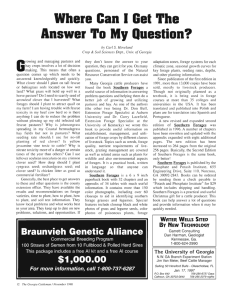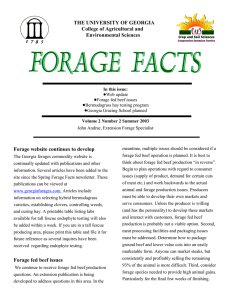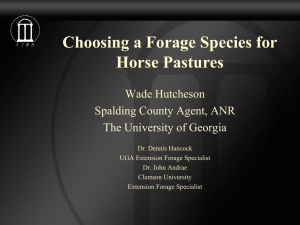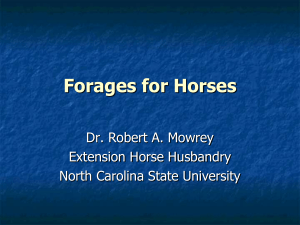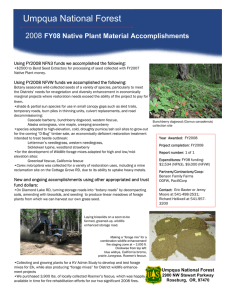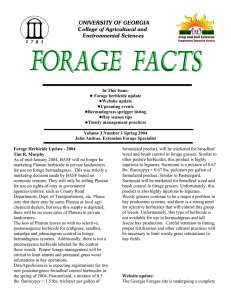UNIVERSITY OF GEORGIA College of Agricultural and Environmental Sciences
advertisement
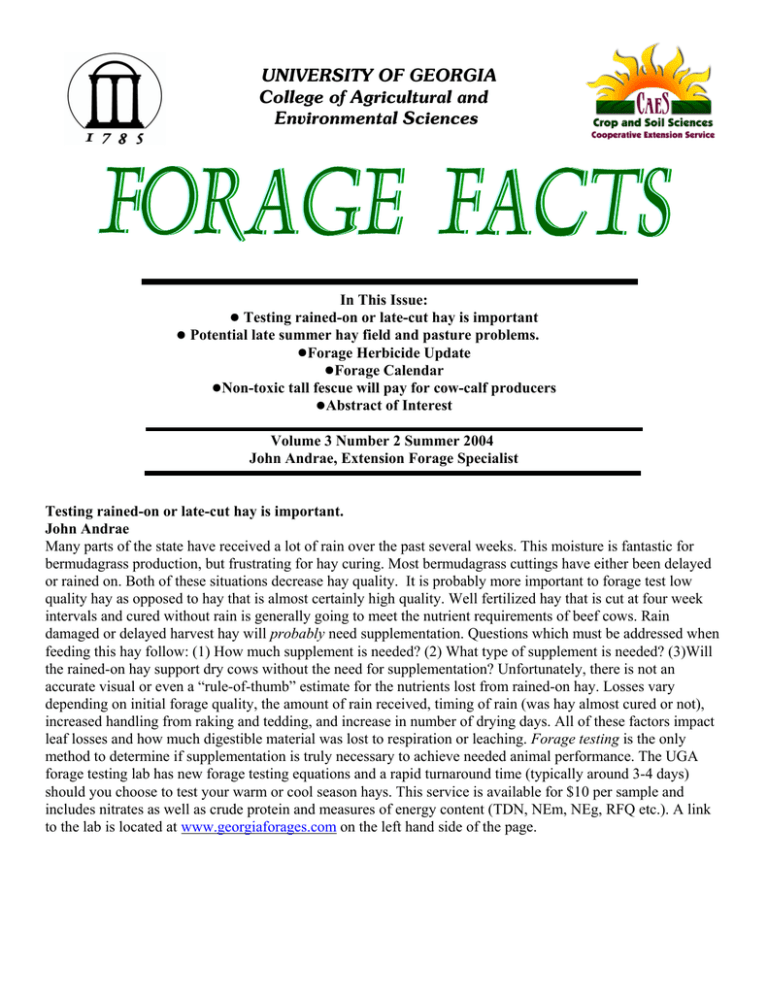
UNIVERSITY OF GEORGIA College of Agricultural and Environmental Sciences In This Issue: ! Testing rained-on or late-cut hay is important ! Potential late summer hay field and pasture problems. !Forage Herbicide Update !Forage Calendar !Non-toxic tall fescue will pay for cow-calf producers !Abstract of Interest Volume 3 Number 2 Summer 2004 John Andrae, Extension Forage Specialist Testing rained-on or late-cut hay is important. John Andrae Many parts of the state have received a lot of rain over the past several weeks. This moisture is fantastic for bermudagrass production, but frustrating for hay curing. Most bermudagrass cuttings have either been delayed or rained on. Both of these situations decrease hay quality. It is probably more important to forage test low quality hay as opposed to hay that is almost certainly high quality. Well fertilized hay that is cut at four week intervals and cured without rain is generally going to meet the nutrient requirements of beef cows. Rain damaged or delayed harvest hay will probably need supplementation. Questions which must be addressed when feeding this hay follow: (1) How much supplement is needed? (2) What type of supplement is needed? (3)Will the rained-on hay support dry cows without the need for supplementation? Unfortunately, there is not an accurate visual or even a “rule-of-thumb” estimate for the nutrients lost from rained-on hay. Losses vary depending on initial forage quality, the amount of rain received, timing of rain (was hay almost cured or not), increased handling from raking and tedding, and increase in number of drying days. All of these factors impact leaf losses and how much digestible material was lost to respiration or leaching. Forage testing is the only method to determine if supplementation is truly necessary to achieve needed animal performance. The UGA forage testing lab has new forage testing equations and a rapid turnaround time (typically around 3-4 days) should you choose to test your warm or cool season hays. This service is available for $10 per sample and includes nitrates as well as crude protein and measures of energy content (TDN, NEm, NEg, RFQ etc.). A link to the lab is located at www.georgiaforages.com on the left hand side of the page. Potential late summer hay field and pasture problems. John Andrae Spittlebugs were a large issue in many bermudagrass hay fields last summer due to the relatively wet weather. Several reports have already come in this year regarding these insects. There is not an effective treatment for spittlebugs other than a dormant season burn to remove eggs. For a recent newsletter article on spittlebugs, check out Robert Morgan’s writeup in the Fall 2003 issue of Forage Facts archived at (http://www.georgiaforages.com). Wet humid weather also can result in leaf spot (Helminthosporium spp.) in bermudagrass hayfields and pastures. There is also little that can be done to control this in forages after symptoms appear. In severe cases it will be necessary to remove standing forage to encourage regrowth. Preventative action is the best insurance against leaf spot. Establish resistant varieties and maintain adequate soil potassium levels before the problem occurs to reduce the incidence of this disease. Forage Herbicide Update Tim R. Murphy Herbicide for Newly Sprigged Forage Bermudagrass. Several years ago Karmex (diuron) was labeled for use at the time of sprigging forage bermudagrass. Unfortunately, the manufacturer of Karmex dropped this use from their label. However, other manufacturers of diuron have labeled their products for use at the time of sprigging forage bermudagrass. Products and manufacturers that have labels that permit use of diuron on newly sprigged bermudagrass include: Direx 4L - Griffin Chemical Company Diuron 80 and 4L - Drexel Diuron 4L - Agriliance Note that all brand names of diuron are not labeled for this use. For example, Karmex is not registered for use on newly sprigged bermudagrass. Diuron should be applied immediately after sprigging before weeds emerge. Bermudagrass sprigs should be planted 2 inches deep to lessen chance of injury. Emerged bermudagrass at the time of treatment may be temporarily injured. Do not graze or feed treated foliage for 70 days after diuron application. Diuron is not labeled in established forage bermudagrass. Use rates are 0.8 to 2.4 lbs. ai/acre. For Diuron 4L, product use rates would be 0.8 to 2.4 qts./acre. Preemergence applications of diuron provide fair to good control of crabgrass, crowfootgrass and goosegrass. Additionally, diuron would provide residual control of certain annual broadleaf weeds. Labels of these products may be obtained at www.cdms.net. Clover plantback following Grazon P+D applications. Previously, DowAgrosciences listed a one year clover plantback restriction following Grazon P+D application. Recent research at The University of Georgia, Virginia Tech University, and The University of Tennessee indicates that it is possible to shorten this plantback interval. If no more than two pints per acre of Grazon were applied in the spring (before June) then clover can be planted beginning in October. If greater than 2 pints of Grazon were applied or if application was made between June and September, clover planting should be delayed until the following February. This new labeling will make it much easier to incorporate herbicide control of perennial weeds into a clover-containing grazing system. New herbicides. DowAgroSciences has received registrations for two new postemergence broadleaf control herbicides. PastureGard, a mixture of 0.5 lbs. fluroxypyr ester + 1.5 lbs. triclopyr ester per gallon of formulated product, will be marketed for broadleaf weed and brush control in forage grasses. With the exception of lactating dairy animals, there are no grazing restrictions for Pasturegard. For lactating dairy animals, grazing or harvesting of green forage is not permitted the same growing season following application. Hay should not be harvested within 14 days of a Pasturegard application. Surmount, a mixture of 0.67 lbs. fluroxypyr + 0.67 lbs. picloram per gallon of formulated product, is now registered for broadleaf weed and brush control on permanent grass pasture. This product has demonstrated good to excellent control of blackberry, horsenettle, pricklypear cactus and numerous other woody and herbaceous weeds. Surmount is similar to Grazon P+D in that it contains picloram and is registered for use on permanent grass pastures. However, unlike Grazon P+D, it does not contain 2,4-D. Similar to other pasture herbicides both of these products are highly injurious to legumes. Forage Calendar: South and Middle Georgia Prepare for overseeding fall winter annuals Graze bermudagrass short in September to improve establishment Consider blending rye and ryegrass for a longer grazing season Begin to line up quality cultivars Bermudagrass can be stockpiled for late fall forage Wet fall weather is needed to accumulate needed forage Supplementation may be necessary to maintain animal performance Strip grazing should be implemented to improve utilization Improve winter hardiness of bermudagrass by applying necessary potash North Georgia Plan to overseed tall fescue with white or red clover Dilutes toxins present in fescue Fixes nitrogen Increases grazing season when established Fertilize closely grazed tall fescue with 50 lbs N/acre in mid-August for fall stockpiling Non-toxic tall fescue will pay for cow-calf producers John Andrae and Curt Lacy We recently conducted an economic analysis of a cow-calf MaxQ grazing trial conducted near Calhoun Georgia. In this study, cows grazing MaxQ weaned steer calves weighing 66 pounds more than cows grazing toxic tall fescue. Heifer calves from MaxQ pastures were 44 pounds heavier. Assuming that cows grazing MaxQ will calve at a 90% rate, Dr. Lacy calculated the returns over variable costs, returns over variable and establishment costs, and years to recover establishment costs at various calving rates of toxic tall fescue. Calving Rate on Returns Over Returns Over Years to Toxic Tall Fescue Variable Costs Variable and Breakeven Per Cow Per Establishment Costs Year Per Cow Per Year 90% $18.70 $(0.90) 10.5 80% $55.39 $35.79 3.5 75% $73.74 $54.14 2.7 66% $106.76 $87.16 1.8 At a 90% calving percentage, MaxQ generates positive returns over variable costs but does not quite cover the cost of establishment. However, calving percentages are normally severely impacted by grazing toxic fescue. If we take into consideration the likely possibilities of 66-80 percent calf crops, we can see MaxQ generates considerable net returns, anywhere from $55 to $107 above variable expenses and from $36 to $87 including the cost of establishment, when compared to toxic tall fescue per cow. For a herd of 35 cows this is between $1,895 and $3,050 per year. Since MaxQ is not cheap to establish, almost $200 per acre considering, chemicals, seed, labor, and lost grazing; many producers are curious to know how many years of grazing they need to recoup their investment. The column “Years to Breakeven” in the table addresses this question. If there is no difference in calving percentages, it takes almost 11 years to recover the investment cost of MaxQ. However, when we use a more realistic numbers 75 percent calf crop, we see that MaxQ pays for itself in less than three years. Obviously, the larger the differences in calving percentages, the quicker MaxQ will pay for itself. The complete popular press article outlining this analysis is available at www.georgiaforages.com . Abstract of Interest: On-farm trials of overseeding techniques for improved cool season legume cultivars. D.P. Delaney and D.M. Ball. Overseeding of warm season perennial grass pastures with winter annual grasses is widely practiced in the lower South. Forage legumes are overseeded much less frequently primarily because of difficulties producers have had in obtaining stands. The objective of this project was to compare legume stands obtained by broadcasting seed with no tillage, broadcasting seed after light tillage, or drilling seed. Legumes used were ‘Apache’ arrowleaf clover, ‘AU Robin’ crimson clover, “common” ball clover, a mixture of ‘Santorini’ and ‘Cadiz’ serradella, ‘Durana’ white clover, and ‘Patriot’ white clover. In overseeded plantings made in two Alabama counties in autumn 2001 and two counties in autumn 2002, drilling seed and broadcasting seed following light tillage gave similar results and resulted in much better ground cover in spring than simply broadcasting seed. Crimson clover was the most dependable legume regardless of planting technique as indicated by percent ground cover in spring. Arrowleaf clover, ball clover, and rose clover had similar overall spring ground cover percentages that exceeded those for serradella and the white clovers. Thus planting technique and species of legume planted influence the likelihood of obtaining a stand. (From: The 2004 Conference of the American Forage and Grassland Council. Vol. 13 Proceedings).
